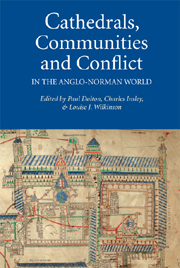Book contents
- Frontmatter
- Contents
- List of Illustrations
- List of Contributors
- Preface
- List of Abbreviations
- Introduction
- 1 The Dangers of Invention: The Sack of Canterbury, 1011, and the ‘theft’ of Dunstan's Relics
- 2 Remembering Communities Past: Exeter Cathedral in the Eleventh Century
- 3 Communities, Conflict and Episcopal Policy in the Diocese of Lichfield, 1050–1150
- 4 The Acta archiepiscoporum Rotomagensium and Urban Ecclesiastical Rivalry in Eleventh-Century Rouen
- 5 Cathedrals and the Cult of Saints in Eleventh-and twelfth-Century Wales
- 6 A Bishop and His Conflicts: Philip of Bayeux (1142–63)
- 7 Ecclesiastical Responses to War in king Stephen's Reign: The Communities of Selby Abbey, Pontefract Priory and York Cathedral
- 8 Secular Cathedrals and the Anglo-Norman Aristocracy
- 9 The Lives of Thomas Becket and the Church of Canterbury
- 10 Caught in the Cross-Fire: Patronage and Institutional Politics in Late twelfth-Century Canterbury
- 11 Crown, Cathedral and Conflict: King John and Canterbury
- 12 The English Monasteries and their French Possessions
- Index of People and Places
- Other Volumes in Studies in the History of Medieval Religion
9 - The Lives of Thomas Becket and the Church of Canterbury
Published online by Cambridge University Press: 12 September 2012
- Frontmatter
- Contents
- List of Illustrations
- List of Contributors
- Preface
- List of Abbreviations
- Introduction
- 1 The Dangers of Invention: The Sack of Canterbury, 1011, and the ‘theft’ of Dunstan's Relics
- 2 Remembering Communities Past: Exeter Cathedral in the Eleventh Century
- 3 Communities, Conflict and Episcopal Policy in the Diocese of Lichfield, 1050–1150
- 4 The Acta archiepiscoporum Rotomagensium and Urban Ecclesiastical Rivalry in Eleventh-Century Rouen
- 5 Cathedrals and the Cult of Saints in Eleventh-and twelfth-Century Wales
- 6 A Bishop and His Conflicts: Philip of Bayeux (1142–63)
- 7 Ecclesiastical Responses to War in king Stephen's Reign: The Communities of Selby Abbey, Pontefract Priory and York Cathedral
- 8 Secular Cathedrals and the Anglo-Norman Aristocracy
- 9 The Lives of Thomas Becket and the Church of Canterbury
- 10 Caught in the Cross-Fire: Patronage and Institutional Politics in Late twelfth-Century Canterbury
- 11 Crown, Cathedral and Conflict: King John and Canterbury
- 12 The English Monasteries and their French Possessions
- Index of People and Places
- Other Volumes in Studies in the History of Medieval Religion
Summary
When Thomas Becket's mother was pregnant with him she is said to have dreamed that she held the whole church of Canterbury in her womb. In another vision her belly swelled to such an extent as she approached Canterbury cathedral that she could hardly squeeze through the door and, when she did, her belly swelled to fill the whole church. Such visions are obviously meant to suggest Thomas's future greatness, with specific reference to the church of Canterbury, but other visions which surrounded his birth would appear to suggest something different. Shortly after Thomas's mother conceived, she is said to have seen the entire river Thames flowing within her. Soon after his birth, the boy was discovered covered with a cloth of precious purple. When his mother and a nurse tried to unfold it, they were told by a voice from heaven that their efforts were in vain: ‘All England is smaller than this purple cloth and cannot contain it.’ The contrast between these visions encapsulates the problem of locating Thomas as a saint. Thomas's memory was firmly associated with a particular place, thanks to his status as archbishop of Canterbury, the occurrence of his murder in Canterbury cathedral and his burial close to the spot where he fell, but at the same time a distinguishing feature of his cult was that it transcended Canterbury, indeed England. The church of Canterbury is central to the study of Thomas's life, conflict and death. yet reading the posthumous Lives of St Thomas, one finds that apart from the murder, few of the best-known scenes concern his church.
- Type
- Chapter
- Information
- Cathedrals, Communities and Conflict in the Anglo-Norman World , pp. 169 - 186Publisher: Boydell & BrewerPrint publication year: 2011



